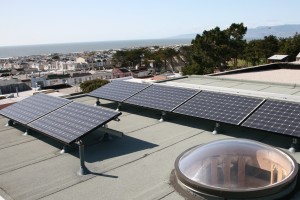Electrical power can be a true mystery. Where does that power you are using right now actually come from? If you don’t generate it yourself, its’ hard to know if it is coal, nuclear, geothermal, wind, natural gas… Were all so tied into the grid, and yet what’s the origin, what’s “the source” as Neo might ask. One tool you can use comes from www.ilovemountains.org Just your average run of the mill activists getting the word out, and in this case its about the power your PC is using to read this. If you click on the link, you can enter your zip code and they can show you if any coal is used to power your home (Probably, we are in North America); where that coal is coming from, and a little about the environmental damage that is done to get it; in the case of coal typically small things, like blowing mountain tops clean off to gouge the coal straight out of the earth.
You know, little stuff.
So if you still have an incandescent light bulb in your house, honestly, at this point, what the “F” is wrong with you?
It always strikes me how dissassociated our homes can be from the environemental damage done to feed them with power, water and building material. If you have ben to this site before you probably know that water consumption is a serious topic with me. I honestly do not care if it is a gallon or an acre foot, it is all on you, me, all of us, to really address our run away use of water. A typical 3rd world citizen uses 3 gallons of water a day. You flush that much every time you use the toilet. And it is not just some “person” living in Africa, Latin America, Asia or wherever that sees the effects of water shortages, though their effects are more profound. California Schinook Salmon Runs Suspended Again read the headline for yesterday’s paper. There is a direct line from the decline of our fisheries to your tap. I do not have a website like Ilovemountians for our fisheries, but maybe one of you will make one. We need to be real about our water use, because as population increases, and water supplies remain, at best, constant, something has to give. And that something must, must be consumption.
This Saturday at 8:30 PM is Earth Hour – one of those global call to action things….interesting note on this is that it traces its history to San Francisco (all good things begin in San Francisco) when “Lights out SF” in 2007 pushed people to turn out their lights in solidarity with the energy conservation movement. You know what, its a freakin good idea. How hard is it to turn out your lights for an hour? Not too hard, and it sends a message that people give a flying fart about the world. Want to go one step further? Check your outdoor light after you turn it off, if it’s an incandescent, and I will bet two pig tails and a sack of corn that it is, change it to a CFL (Compact Flourescent Light). Then when you turn it back on, you have accomplished something long lasting, something Sustainable, out of the whole thing.
 That’s the view from the roof of 2139 39th Ave, my Sustainable Project out in the Sunset District. And lest some of you start making cracks about how the Sunset is Foggy – there have been more than enough sunny days this last year to justify the installation of the 2.3 Kilowatt solar photovoltaic system you see here: we are generating over 1,100 watts right now at 9:27 AM, and by the afternoon we will be cranking out well over 2,000 watts.
That’s the view from the roof of 2139 39th Ave, my Sustainable Project out in the Sunset District. And lest some of you start making cracks about how the Sunset is Foggy – there have been more than enough sunny days this last year to justify the installation of the 2.3 Kilowatt solar photovoltaic system you see here: we are generating over 1,100 watts right now at 9:27 AM, and by the afternoon we will be cranking out well over 2,000 watts.
One thing most folks do not understand about a solar system is how the light is transformed into electrical energy. Well, the photons (light) hits those panels above (they are black to absorb more light) and they create a direct current. Your house uses alternating current electricity to power your ipod and microwave, so that direct current (DC) has to be inverted into an alternating current (AC) using one of these things…

That’s an inverter in the garage that changes the DC into AC….like the band. Except they are AC/DC because, well, oh never mind.
I received a $4,000 rebate check from PG&E for the panels, and if I ever get off my lazy ass and finish the paperwork I have another $3,000 due from the city and county of SF. That plus the cost of the installation does not get added to your property tax basis around here, which is cool. Plus the savings off energy – I still pay the taxes and such, but the electrical line on the bill is zero. And I produce no carbon.
Win, win, win and win.
H
A reader sent me an email the other day asking for a site or calculation that could help him determine how much money he would save if he installed higher R factor insulation. It is a damn good question, and while I referred him to SustainableSpaces for bids and/or an energy audit, it got me thinking about cost savings. Exactly specifically to the dollar and cent how much do we save when we install energy & water saving systems into our homes? It is a personal question as it relates to your baseline usage, and savings will flow from each person differently – my wife likes to point out that I take very long showers, so if I were not so much of a water pig, how many dollars would that add up to over the course of a year? There is this great article on Energy Use from National Geographic that has be inspired to go on an energy diet…I think I will get some baseline costs up, and track how changes in behavior and the installation of new systems impact actual costs, and report back on the savings. I haven’t a clue how to do it, and I should probably let my wife know also, but I will figure it out and post as I go.
H
 That’s the view from the roof of 2139 39th Ave, my Sustainable Project out in the Sunset District. And lest some of you start making cracks about how the Sunset is Foggy – there have been more than enough sunny days this last year to justify the installation of the 2.3 Kilowatt solar photovoltaic system you see here: we are generating over 1,100 watts right now at 9:27 AM, and by the afternoon we will be cranking out well over 2,000 watts.
That’s the view from the roof of 2139 39th Ave, my Sustainable Project out in the Sunset District. And lest some of you start making cracks about how the Sunset is Foggy – there have been more than enough sunny days this last year to justify the installation of the 2.3 Kilowatt solar photovoltaic system you see here: we are generating over 1,100 watts right now at 9:27 AM, and by the afternoon we will be cranking out well over 2,000 watts.

